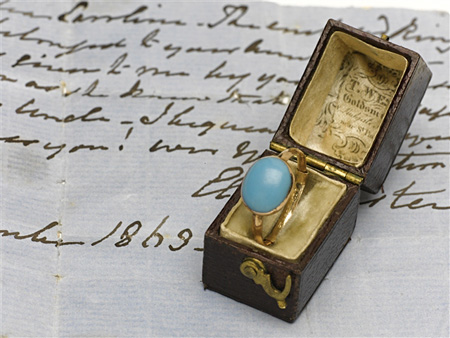
A rare portrait of the British author Jane Austen hit the auction block last week, bringing in US$270,600 at Sotheby’s London. The watercolor portrait of the famed author, estimated to bring in £150,000–200,000, was the highlight of the English Literature, History, Children’s Books, and Illustrations sale on December 10. Painted by James Andrews (British) in 1869, more than 50 years after her death, this work has become one of the most recognizable images of Austen.
This likeness was commissioned by Reverend James Edward Austen-Leigh, Austen’s nephew, to accompany his biography of her. To create his portrait, Andrews used an earlier sketch of Austen, now housed in the National Gallery in London, drawn by her sister during the author’s lifetime. Though created after Austen died, this portrait has become the accepted image of Austen, and has been widely reproduced. Handed down through the Austen family, the portrait’s strong provenance, well-documented history, and limited exhibition make it a rare and unique gem.
James Andrews, Portrait of Jane Austen, 1869, watercolor over pencil heightened with gouache on card, sold at Sotheby’s London
This same image will soon be reincarnated in 2017 on England’s £10 note to mark the bicentenary of her death, a decision met with some opposition due to the claim that Austen’s visage had been altered to appear more modern and aesthetically pleasing. And this isn’t the only recent controversy surrounding Austen memorabilia. When a gold and turquoise ring that belonged to Austen was sold in 2012 to the American singer Kelly Clarkson, uproar erupted regarding its cultural importance to English history. An export ban was placed on the ring in an effort to allow Jane Austen’s House Museum to raise funds to purchase the ring. Clarkson, an Austen fan who bought the ring for over five times its estimate at US$231,227, agreed to sell the ring to the museum once they raised the funds.
Andrews’s portrait was purchased by an anonymous bidder, and it is not yet known if this painting of Austen will encounter the same export difficulties as the ring after purchase. These two items are the only recent heirlooms that the Austen family has parted with, leaving the market for Austen memorabilia rather small, increasing both the monetary and sentimental value of these pieces. The high-selling price of this treasured image of Jane Austen attests to the strong resonance her work has with readers almost 200 years after her death.